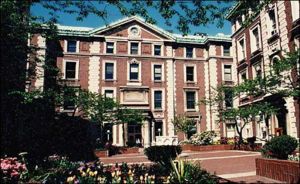Difference between revisions of "Schermerhorn Hall"
| Line 1: | Line 1: | ||
[[Image:Schermerhorn.jpg|thumb|300px|Schermerhorn Hall]] | [[Image:Schermerhorn.jpg|thumb|300px|Schermerhorn Hall]] | ||
| − | |||
'''Schermerhorn Hall''' (pronounced sker-mer-horn) was built in [[1896]] to house the "natural sciences." An inscription above the doorway reads "For the advancement of natural science. Speak to the earth and it shall teach thee." Today Schermerhorn is home to the African-American Studies; Anthropology; Art History and Archaeology; Geology; Psychology; Women's Studies; and [[E3B]] departments. It also houses the [[Wallach Art Gallery|Miriam & Ira D. Wallach Art Gallery]] and the [[Center for Environmental Research and Conservation]] (CERC). | '''Schermerhorn Hall''' (pronounced sker-mer-horn) was built in [[1896]] to house the "natural sciences." An inscription above the doorway reads "For the advancement of natural science. Speak to the earth and it shall teach thee." Today Schermerhorn is home to the African-American Studies; Anthropology; Art History and Archaeology; Geology; Psychology; Women's Studies; and [[E3B]] departments. It also houses the [[Wallach Art Gallery|Miriam & Ira D. Wallach Art Gallery]] and the [[Center for Environmental Research and Conservation]] (CERC). | ||
| Line 9: | Line 8: | ||
Directly behind and connected to Schermerhorn and is Schermerhorn Extension. The easiest way to get to a room in the extension is to enter Schermerhorn, make a right, walk until the end of the hallway, make a left, go all the way forward and down a few stairs and make a right, then another left. You're now in the Extension. On your right are a bank of elevators that will get you to the rest of the floors. Alternatively, enter the service gate on 118th St and [[Amsterdam Ave]] during the daytime and use the door immediately on the left if it's still open. | Directly behind and connected to Schermerhorn and is Schermerhorn Extension. The easiest way to get to a room in the extension is to enter Schermerhorn, make a right, walk until the end of the hallway, make a left, go all the way forward and down a few stairs and make a right, then another left. You're now in the Extension. On your right are a bank of elevators that will get you to the rest of the floors. Alternatively, enter the service gate on 118th St and [[Amsterdam Ave]] during the daytime and use the door immediately on the left if it's still open. | ||
| + | |||
| + | == Photos == | ||
| + | <gallery> | ||
| + | Image:SchermerhornFront.jpg | ||
| + | Image:Flickr-jasonhe-schermerhorn.jpg | ||
| + | </gallery> | ||
[[Category:Buildings on the Morningside Heights campus]] | [[Category:Buildings on the Morningside Heights campus]] | ||
Revision as of 01:18, 27 October 2007
Schermerhorn Hall (pronounced sker-mer-horn) was built in 1896 to house the "natural sciences." An inscription above the doorway reads "For the advancement of natural science. Speak to the earth and it shall teach thee." Today Schermerhorn is home to the African-American Studies; Anthropology; Art History and Archaeology; Geology; Psychology; Women's Studies; and E3B departments. It also houses the Miriam & Ira D. Wallach Art Gallery and the Center for Environmental Research and Conservation (CERC).
Thomas Hunt Morgan conducted his Drosophila experiment in his Schermerhorn "Fly Room".
Schermerhorn Extension
Directly behind and connected to Schermerhorn and is Schermerhorn Extension. The easiest way to get to a room in the extension is to enter Schermerhorn, make a right, walk until the end of the hallway, make a left, go all the way forward and down a few stairs and make a right, then another left. You're now in the Extension. On your right are a bank of elevators that will get you to the rest of the floors. Alternatively, enter the service gate on 118th St and Amsterdam Ave during the daytime and use the door immediately on the left if it's still open.


